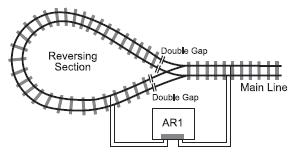
Everything on model trains, model railroads, model railways, locomotives, model train layouts, scenery, wiring, DCC and more. Enjoy the world's best hobby... model railroading!
Ron Bailey sent in this question:
 “I am working on my OO gauge layout in my garage and will have a reverse loop. I have been told about the Digitrax AR1 automatic loop. I am wondering how to wire things as there are a couple of dead end sidings in the loop? A portion of the loop is the main line so I was curious how the reverse loop would operate with these sidings?”
“I am working on my OO gauge layout in my garage and will have a reverse loop. I have been told about the Digitrax AR1 automatic loop. I am wondering how to wire things as there are a couple of dead end sidings in the loop? A portion of the loop is the main line so I was curious how the reverse loop would operate with these sidings?”
Drawing credit: digitrax.com
Hi Ron I have the exact same set up with reverse and sidings.unless you wire the sidings separately they are dead until you change the points to allow an engine access, then the sidings are live but the rest of the loop is dead. Wireing separately is easy, just put a couple of insulated fish plates on at the point to sidings line then wire up the sidings and rest of loop.i don’t know if this is how the experts do it as I only have 4 years experience with DCC but it works. Good luck Graeme
Hi Ron
You can make the isolation track smaller than the whole loop Mine is just long enough to allow the engine to sit plus about 4 inches extra make sure the sidings are on the live side of the loop and wired to the main bus wires
I am told this will work with DCC but not DC. If you haves a DC track you need double pole double throw (DPDT) to maintain the direction of travel by reversing the polarity
I use bipolar LEDs. Entering the reverse loop the LED must be the same color. Exiting the loop, the LED
On the main line should be the opposite. Your LED is green entering the reverse loop which is also green. Leaving the reverse loop, the main line should be red.
Ron;
I am assuming you are running with DCC on your layout. If you are running your rolling stock on metal wheels then the length of your reversing section must be longer than the longest train you intend to run over the reversing loop. The AR1 should be connected to each end of the loop as well as to a power supply which can be track power outside the loop.
Turnouts and sidings should be wired in exactly the same way they are on the rest of your layout. The only thing to ensure is the power supply comes from the track inside the loop unless you are planning to be running trains on the loop and sidings at the same time. If so they must be isolated from each other. You must not have one train entering the loop before the siding train is off the loop.